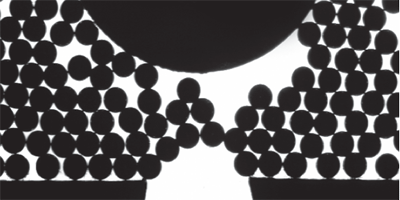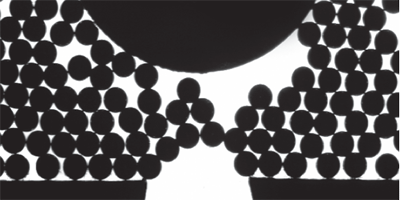Even Flow
Fine particles, like flour or sugar, passing through a constriction (for example, a funnel) can clog for no apparent reason. Even when the particles are much smaller than the aperture, clogging occurs, as the particles, under pressure from the medium, form an arch at the outlet. This behavior is the same for grain discharging from a silo, people escaping a room, and traffic congestion.
Placing an obstacle just before the exit is known to inhibit the formation of transient clogs that increase the exit time; however, the exact way in which the obstacle decreases clogging is still an open question. Writing in Physical Review Letters, Iker Zuriguel and collaborators at the Universidad de Navarra, Spain, have performed experiments on a two-dimensional model of a silo with an obstacle at different distances from the silo exit. For all cases, except for when the obstacle is very close to the outlet, the clogging probability is smaller than without the obstacle, and by choosing the position of the obstacle carefully, the probability that a clog will form is reduced by 2 orders of magnitude. The clog probability is lowest when the distance of the obstacle to the outlet is about the same as the size of the outlet.
The authors suggest that the obstacle effectively reduces the pressure spots that lead to the formation of arc structures by the outlet. Although this study only treats two-dimensional silos, it should be applicable to three-dimensional flows as well. – Daniel Ucko





